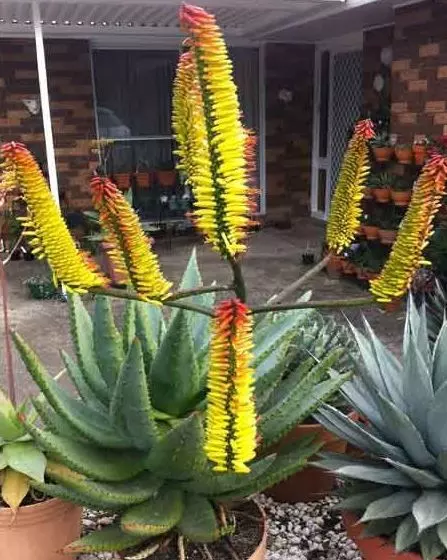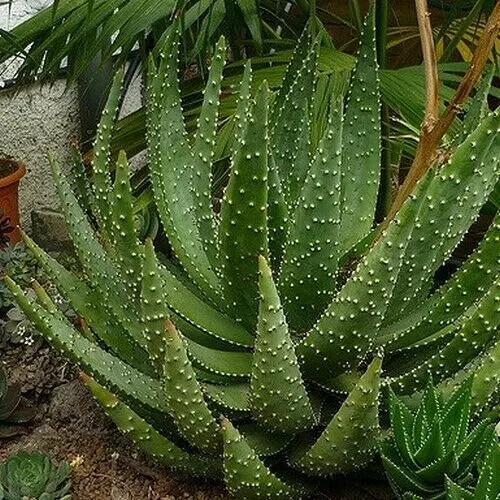Lately, I feel very attracted to this type of aloe with large thorns, as they remind me of dry desert landscapes, where only the strongest can adapt and survive. Learn all about Aloe aculeata in this post.
In particular, this variety of aloe has some characteristic spikes not only on the edges of the leaves, but these are arranged on the inside and outside of the leaves
Table of Contents
Origin and Habitat Aloe aculeata
It has its origin in the South African region called Mpumalanga and spreads throughout the northwest of the country including southern Zimbabwe.
Like many other South African aloes, Aloe Aculeata grows prolifically in rocky and plain areas where it shares space with other shrubs and bushes.
To begin describing this beautiful aloe, we have to start looking for clues in its name; Aculeata comes from the Latin aculeatus which means “sharp, cutting”. If a plant carries the surname “aculeata”, it is certain to have thorns.
Indeed, this aloe, which reaches up to one meter in height and another meter in diameter in a suitable environment, usually planted in the ground and not in a pot, has strong tuberculous thorns all over the surface of the leaves.
What are Rosettes Like?
Rosettes are composed of pairs of flat, thick leaves, unlike other aloes in which they are composed of trios. When the rosettes are young, the pairs of leaves grow vertically and as they age they begin to curve slightly giving a semi-sphere shape to the plant.
What are the Leaves Like?
The size of the leaves varies depending on the age of the plant, as it is logical, being able to reach almost a meter in length in the oldest leaves of mature plants.
The leaves are usually wider at the base, of a dull green color due to the pruina that this plant generates. The colors of the sides and back can reach reddish-brown tones when exposed to the sun for long periods.
The thorns arise from lighter green protuberances on the leaves. These spines harden over time, as well as change color to darker shades of brown as the plant matures. Curiously we could find very old plants without thorns as they also become more brittle and once they break they do not grow back.
Flowers of Aloe aculeata
The flowering of this aloe is curious as some plants present a uniform yellow color, however, others have flowers ranging from reddish, orange, and yellow-greenish tones.
As in all aloes, the flowers are tubular, about 1.6” (4 cm) long, and slightly flattened downwards. The flowers of this aloe are precisely one of the features that help differentiate it from other South African varieties.
Aloe aculeata blooms in mid-winter through a single flower scape in young plants and up to 3 or 4 in the case of more mature plants. This scape can be more than 3.3 ft (1 m) long.

Aloe aculeata Care: Substrate
This variety of aloe is no different from most when it comes to soil, so you should grow it in a sandy mix with large particles as it needs good drainage. You can create your substrate or buy a commercial cactus mix.
Pots
You need a relatively shallow pot to accommodate its fibrous roots and provide very good drainage. In case your pot is too deep, you can reduce the volume by adding pebbles at the bottom to help drainage. Keep in mind that this plant can remain in the same pot for many years, so look for a good terracotta pot.
Aloe aculeata Care: Watering
This species requires regular water in summer but needs very little water in winter as it is dormant during this period of the year. It stays dry in winter or when night temperatures stay below 50 °F (10° C). Water is less than average if it is in larger pots.
Aloe aculeata Care: Fertilization
Light fertilizer seems to boost their growth each time additional water is given.
Fertilize during the growing season with a fertilizer specifically formulated for cacti and succulents (high potassium fertilizer with a low level of dilute nitrogen), including all micronutrients and trace elements diluted to ½ the concentration recommended on the label.
Aloe aculeata Care: Lighting
It enjoys light-shade. This succulent can also grow in full sun, but in summer protect it from the afternoon sun and avoid reflected heat. It will do its best with some sun and will be stressed with inadequate light, which could result in poor growth and an unnatural form.
Leaves that receive ideal light conditions (direct sunlight) turn a lovely red and orange, they also tend to turn red in low water and cold situations, a sign usually associated with stress.
Provide very good ventilation. Almost all problems occur as a result of overwatering and poor ventilation, especially when weather conditions are dull and cool or very humid.
Aloe aculeata Hardiness
Likes warmth (recommended minimum winter temperature 41 °F (5° C) however plants that are kept perfectly dry can survive low temperatures, approximately 28.4 °F (-2° C) for short periods, but for safe cultivation, it is best to avoid freezing temperatures.
Aloe aculeata Propagation
Aloe aculeata is relatively easy to grow in a wide variety of weather conditions, provided it is planted in a well-drained situation, with adequate but not excess water.
The most common propagation is by seed, as it rarely develops tillers. Seeds should be sown as fresh as possible and the best time for sowing would be in spring or summer when temperatures are warm.

